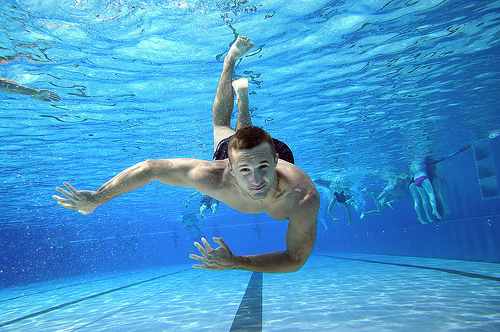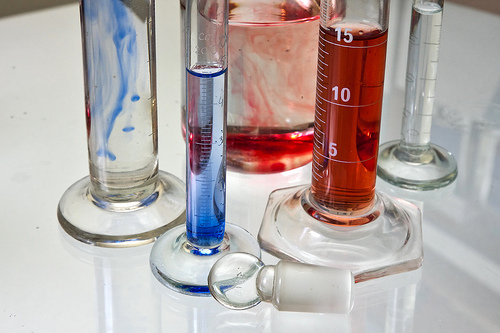Looking after a swimming pool can be a daunting prospect if you have never done so. In this article we’ll break down the basic swimming pool chemistry you need to know about and try to teach you the basics maintenance that you’ll need to run on your in ground swimming pool.
Basic Pool Maintenance Tips
- pH should be maintained between 7.2 and 7.6
- Chlorine levels should be between 1-3 ppm, about 2.5 ppm is ideal
- Run your pools pump for at least 8 hours per day
- An ideal temperature for an outdoor pool is 78 degree Fahrenheit

image by danks.de
Testing Your Swimming Pool
Ideally you should test your swimming pool everyday. As you learn how your pool reacts to both the water in your area, the weather and the amount of use your pool gets you may be able to get away with testing less frequently. Every swimming pool reacts differently so there are no set formula to any aspect of swimming pool chemistry.
When taking a sample of water always try to gather it from at least 30cm below the surface and away from the swimming pool wall.
Swimming pool test kits come in many shapes and sizes however as a minimum you should be testing the pH and chlorine levels on a regular basis. If you can maintain these two measures within the ranges stated above then you should have a relatively trouble free maintenance routine.
If you struggle to maintain one or both of these levels (pH & chlorine) or suffer other symptoms such as cloudy water you may need to take further tests or provide a water sample to a local pool specialist to diagnose the problem.
How to Add Chemicals To Your Pool
Be careful. The chemicals used in swimming pool maintenance can be dangerous if not handled correctly. By taking a few simple pieces of advice you can avoid any mishaps and will be able to enjoy your pool safely.
If you are planning on adding chlorine and acid to the pool never mix them together as this can be potentially explosive. While they can be added to the pool at the same time always mix them with water seperately (in different containers) and add them to different ends/side of the pool to prevent any nasty reactions.
The easiest way to add chemicals to your pool is by using an old watering can. Fill the watering can 3/4 full with water from the pool then add the required chemical (granules or liquid). Stir carefully (avoid splashing the water on your or your clothing) with a stick then walk around the pool pouring in the contents of the can. This will ensure the chemical dose is added in an even distribution.
After dosing your pool always leave the cover off and ensure the pump is running for at least 1 hour before anyone enters the pool. This will ensure there are no potentially harmful concentrations of chemicals in the water. Always retest the water before swimming in a recently shocked pool to ensure the chemical levels are safe for swimming (see the basic tips above). If at all possible leave 12 hours between shocking a pool and retesting and swimming.
Add The Right Amount of Chemicals To Your Pool
One thing I experienced when I first took over maintenance of a pool was getting the right measurements of chemicals to add. The dosage instructions instructions on pool chemicals (for granules anyway) usually require you to measure a particular weight of granules based on your pools capacity. It can be tricky to judge what 400 grams of acid granules looks like when pouring them from a 5kg container.
 image by Horia Varlan
image by Horia Varlan
To make measuring your chemicals easier, for each chemical i regularly use (acid granules, chlorine granules & alkaline granules) I have an old plastic cup that I have weighed when fully loaded with chemical. Therefore I know 1 cup = 200gams of chlorine granules. There if i want to raise the chlorine level of my pool (11,000 m3) by 1ppm i’ll need to add about 90g of chlorine granules which is just under 1/2 cup.
Being able to add the exact amount of chemicals required will help you keep the pools chemistry exactly where you want it much more easily.
Swimming Pool Chlorine Levels
As mentioned above the ideal level of chlorine in a swimming pool is about 2.5ppm. If the pool falls below 1ppm bacteria can grow which can be potentially harmful and it is not wise to use the pool. When the chlorine levels read over 6 ppm you may experience problems with stinging eyes which can make your swimming experience unpleasant.
If your chlorine levels are too high then you’ll need to add some chlorine to the swimming pool. You can either add dissolved chlorine granules or liquid to increase the chloring levels. Also if you pool is in regular use you can keep a couple of chlorine tablets in the pools skimmer to help maintain the levels for longer.
Reducing The Chlorine Levels
Sometimes you may need to reduce the chlorine levels. On occasions you may get impatient and over shock the chlorine levels. One easy and effective way to reduce the chlorine levels in a pool is to run the hosepipe into the pool for a couple of hours. Also sunlight has the effect of killing chlorine so leaving the cover off on a sunny day will naturally reduce the chlorine levels of the water.
As a general rule if you add chlorine to a swimming pool the pH will rise. As a result it may be necessary to add acid to the pool first to reduce the pH level if you need to shock the chlorine levels.
Swimming Pool pH Levels
Again as we mentioned above the ideal pH for a swimming pool is pH7.2. This is the same pH that our eyes have is at this level. Every pool varies but you will probably find that over time your pH level will either drop or rise away from this neutral level. As the pH moves away from neutral the effectiveness of any chlorine you add can also be reduced making it crucial to maintain your pools pH at an acceptable level.
How to reduce a swimming pools pH
If your pools pH level is too high you can add some acid to reduce the pH. In an average swimming pool 400 grams of acid granules will reduce the pH by about 0.2. Of course different pools will react to different chemicals so always use the dosing levels on the instructions that come with the acid you
buy and work out the correct dose levels according to the exact capacity of your swimming pool. Likewise to increase the pH level you’ll need to add some alkaline granules.
Related Articles: